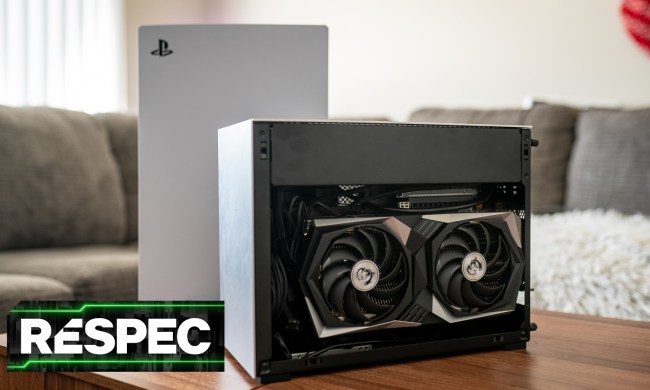While the best VR headsets of yesteryear were built for gaming, companies are moving toward augmented reality for virtual computing. Devices like Apple’s Vision Pro promise spatial computing, and Meta has been chipping away at its vision of Augmented Reality (AR) for years. A lot of attention has been paid to the headsets you strap on, but not the interface with which you interact with the virtual world.
Afference, a team composed of a neural engineer, neural interface expert, and perceptual scientist based out of Boulder, Colorado is looking to change that, and it’s developing a new tool that may just change how you interact with your PC forever.
Phantom Feelings
The problem Afference has set out to solve with its Phantom glove is simple: How can we create synchronized tactile sensations with what the user sees visually? Anyone who experiences VR outside of simple visual experiences understands this problem. When we interact with an object, or even something as simple as pressing a button, our brains anticipate force feedback. When what we’re doing doesn’t sync up with what our sensory organs expect, and that’s where cybersickness can occur. The technology behind the Phantom intends to give our brains that feedback to complete the loop.

While speaking to the team in its Boulder office, I was given the chance to test out a prototype of the device. In these early stages, the glove as a whole is not yet functional, so I was hooked up to a single finger ring rather than the final product, which will work with the entire hand. The rings are the key component of the device. In simple terms, the ring will translate whatever sensation is fed to it, such as the force of pressing a button or even the intensity of a fire, into electrical impulses that directly interact with the wearer’s nerves. In other words, it tricks your nerves into telling your brain that you’re feeling something.
Calibrating the device had me experience the sensation the ring would be giving off at various intensities. This was done through sounds. The first, and perhaps most important, aspect the team looked to implement was automatically translating sounds into these electrical inputs sent to the device. Aside from the hardware, Afference is essentially attempting to create a platform for developers rather than bespoke software itself. By creating a system for sounds to be translated into sensations, developers don’t need a specialist to design the device.
I was run through several sounds in this stage, starting off with a simple laser that hit my finger with a sharp buzz. This first impression wasn’t all that, well, impressive. I was anticipating something more tactile or unique in the feeling the ring would give me, but it mostly felt like I was getting a light electrical current sent to my finger. The few sounds that followed — a sword unsheathing, a light switch clicking, rain dripping — all felt more or less identical but in different patterns. The most impressive from this batch was the car starting and revving. On this test, I could start to get a better idea of the device with the kick of the engine starting and the uneven rumble of the engine idling in by hand.
Touching cyberspace

The technology finally connected with me when we moved over to the AR demos. Unlike the first tests, where I was simply hearing sounds with no interaction or visual cues, the combination of the two in AR completed the trick. My first set of tests included a virtual fire I could put my hand over and, as I moved it further and closer to the source, would get a stronger or weaker response from the ring. Because the device cannot actually simulate temperatures — which the team isn’t sure yet if such a thing is possible when I asked — the illusion wasn’t quite perfect. The following tests were when I really started to become a believer.
First were the buttons. One was the comically large red button you would see in cartoons or games typically labeled “do not press” or something of the sort. When my hand made contact with it, I got a baseline of feedback in the ring and, as I depressed the button further, that feedback grew in strength. The result of that growing sensation and visual of the button moving down was a startlingly convincing feeling of resistance I would expect from pressing a big button.

Of course, there was no real resistance, but that signal I was getting from my hand combined with what I was seeing managed to trick me just enough to naturally slow down and stop when the button was fully pressed instead of my hand just swishing through it. The other demo was a blank keypad. These had a distinct feel compared to the larger button that had a longer depression time, feeling more immediate and “clicky” as you would expect from a keyboard-like device. Despite only being able to use one finger with them, I could envision myself working on some sort of virtual keypad in the future, although I don’t think the tight keyboard designs we’re familiar with now will translate.
As something of a hardcore gamer, I was especially excited by the next demo. VR games tend to include some form of telekinetic abilities to make grabbing objects viable in limited movement spaces. It’s just a necessary concession developers have to account for since most people don’t have massive open spaces to dedicate to VR rooms. This demo consisted of a small yellow object on the far side of the room. As I held my hand up a line appeared between it and the object, as well as a slight rumbling in my finger, to tell me I had targeted the object. Closing my hand called the object through space into my hand with a satisfying jolt. It was the absolute closest I had ever felt to being a Jedi and force-pulling an object, and I couldn’t get enough of it. That’s even with using a prototype that provides a fraction of what the full glove device would offer.
Early goings
As mentioned, Afference has only been fully funded for a year this October, and the complete Phantom device is not fully developed. If you want to get your hands on this new tech, it may be a little while, and probably not even look like the first iteration. The current road map is to complete the Phantom glove and make it available primarily for enterprise use to start.
As the market grows, and Afference hones its technologies, it plans on redesigning the device for consumer use to a bracelet form factor, and possibly even a single ring. Those iterations will be years off yet, but for enthusiasts out there who want to stay on the cutting edge of immersive tech, this is one company you may want to keep your eye on.



